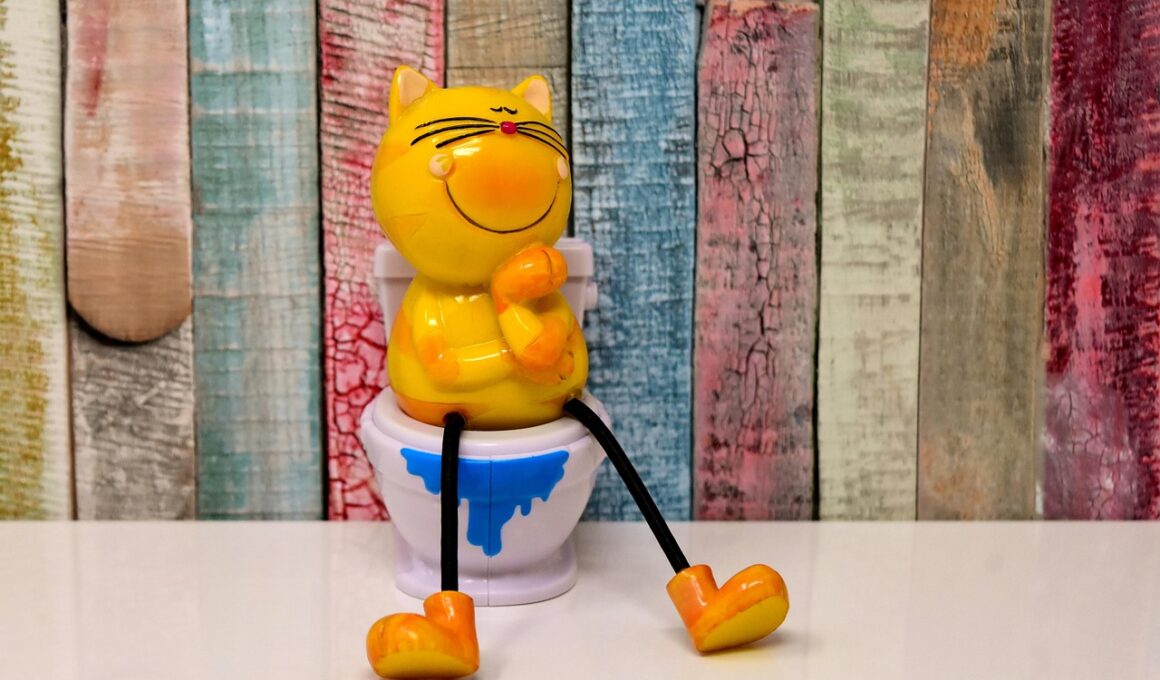Litter Box Maintenance Tips Based on Litter Type and Kitten Needs
Maintaining a litter box requires understanding the various litter types available. There are numerous options, each providing unique benefits for your kitten’s needs. Managing a clean and comfortable environment is crucial for your kitten’s health and happiness. Some common litter types include clumping clay, non-clumping clay, crystal, and biodegradable litter, all catering to different preferences. Clumping clay provides easy cleaning, as it forms solid clumps when wet, making waste removal simple. Non-clumping varieties absorb moisture but may need to be replaced entirely more frequently. Crystal litter, often made from silica gel, is known for its low dust and odor control. Finally, biodegradable litters come from natural materials, appealing to environmentally-conscious pet owners. Understanding these types can significantly influence your litter box maintenance strategy. Regularly scooping out waste is critical, ideally daily, to encourage your kitten to use the box consistently. Additionally, ensuring that the litter is deep enough promotes digging and comfort. Observing your kitten’s behavior can also identify preferences and necessary adjustments to litter types that support their specific needs.
When selecting litter for a kitten, age and comfort are essential factors to consider. Kittens may prefer softer varieties that are easier on their sensitive paws. Clay litters, especially clumping, can sometimes be rough, making them less suitable for very young or sensitive kittens. Alternatively, you could explore softer, natural materials like pine, paper, or corn-based litters. These alternatives are generally gentler and might enhance your kitten’s comfort in the litter box. Providing a variety of litter types can help determine your kitten’s preference. Introducing several options gradually can prevent them from feeling overwhelmed. It’s also vital to keep the litter box environment positive. Avoid harsh scents or perfumes in the litter, as kittens can be sensitive to strong odors. Ensuring the box is located in a quiet, easily accessible area is crucial for encouraging usage. Once you identify the ideal litter type, establishing a consistent cleaning routine will promote hygiene. Routine maintenance ensures your kitten feels secure using the litter box and helps prevent future behavioral issues.
Cleaning and Hygiene Practices
Maintaining a clean litter box is fundamental to your kitten’s health and well-being. Daily scooping is necessary to remove clumps and solid waste, but thorough cleaning should be done weekly. During the weekly deep clean, dispose of all the old litter and wash the box with warm, soapy water. Avoid strong chemicals or fragrances that could deter your kitten from using the box again. Some pet owners recommend using vinegar as a natural disinfectant. After cleaning the box, dry it completely before adding fresh litter to prevent clumping. The goal is to create a welcoming environment your kitten enjoys, reinforcing positive bathroom habits. Moreover, observe for changes in your kitten’s behavior, as any signs of avoidance might signal discomfort in the litter box. Adjusting hygiene practices based on your observations can help maintain a pleasant experience. Ensuring that the litter box remains odor-free is vital, as unpleasant smells can discourage use. The right balance of hygiene and comfort leads to a successful litter box experience, preventing accidents and improving overall kitten happiness.
Paying attention to the litter box placement significantly influences your kitten’s comfort and willingness to use it. Choose a location that is quiet and private to minimize distractions. Cats are naturally private creatures, often preferring secluded spots for their bathroom needs. Hiding the litter box in a high-traffic area can lead to anxiety, causing your kitten to avoid it altogether. If you have other pets, consider a location that is inaccessible to them, ensuring that your kitten feels safe. Furthermore, avoid placing the litter box near their food and water dishes, as cats tend to separate their eating and bathroom spaces. The number of litter boxes matters too; many experts recommend having one box per cat, plus one extra for optimal comfort. This ensures that the litter box is readily available and reduces the risk of territorial disputes between pets. By adjusting the litter box location and surrounding environment, you can encourage your kitten’s consistent use and promote good litter habits that will last well into adulthood.
Learning Your Kitten’s Preferences
Understanding your kitten’s litter box preferences is essential for developing their bathroom habits. Observe which litter texture and type seem to please them the most. Kittens may become accustomed to litter choices based on their experiences early on, so offering familiar options can ease transitions. If your kitten shows signs of distress or hesitance when using the box, consider trying a softer litter or changing the style altogether. Take the time to experiment with various options, including fine-textured clumping litter and natural alternatives made from recycled materials. Additionally, it’s beneficial to routinely monitor the amount of litter you use. Maintaining an adequate depth encourages digging and instinctual behaviors. A depth of two to three inches is typically ideal for most kittens; ensure this amount is refreshed regularly. If you notice your kitten kicking the litter out of the box, it might be worth exploring boxes with higher sides or lids to minimize spillage. Such observations and adjustments can make a noticeable difference in your kitten’s comfort and satisfaction while using the box.
As your kitten grows, their litter box requirements may change, requiring regular adjustments for ongoing success. Kittens are adventurous and continue to develop their exploration skills. Therefore, as they mature, they may require changes in litter types. Transitioning from a finer, softer litter to a more textured one can reflect their evolving needs. This transition should be gradual to ensure your kitten adapts without becoming stressed. Monitor their reactions closely during changes; if accidents occur, it may signal that something needs adjusting. As kittens begin to form habits, keeping consistency in litter types can be crucial for maintaining reliable behavior. Moreover, your cleaning schedule may need adjusting based on your kitten’s changing preferences. They may require more frequent litter changes as they grow larger and potentially messier. Their comfort and health remain paramount, so it’s essential to remain observant and responsive to their needs. By maintaining an adaptive approach to litter box care, you can help promote a lifetime of positive habits and comfortable bathroom experiences.
Conclusion
In conclusion, effective litter box maintenance hinges on several factors, including litter type, cleaning routines, and individual kitten preferences. Understanding each kitten’s unique needs creates an environment that supports healthy habits. Daily and weekly cleaning should incorporate thorough assessments of behaviors and preferences to optimize comfort. Experimenting with various litter types is essential, ensuring a softer, gentler option for kittens while still acknowledging grooming habits. Addressing the location and depth of the litter box can significantly impact a kitten’s willingness to use it. Additionally, recognizing their behavioral cues will enable the development of holistic and adaptable care practices. As your kitten transitions into adulthood, continue reassessing their needs and preferences. Through patience and observation, you can achieve a well-maintained litter box experience. Ultimately, a clean, comfortable space can lead to increased satisfaction for both you and your furry companion. Proper litter box care contributes immensely to a positive environment, enhancing your bond and ensuring that your kitten grows into a well-adjusted cat.
Remember, a vital aspect of kitten care revolves around providing a positive, safe, and clean bathroom environment. By integrating these maintenance tips with the right litter type tailored to your kitten’s needs, you will foster elevated health, comfort, and happiness in their daily lives.


